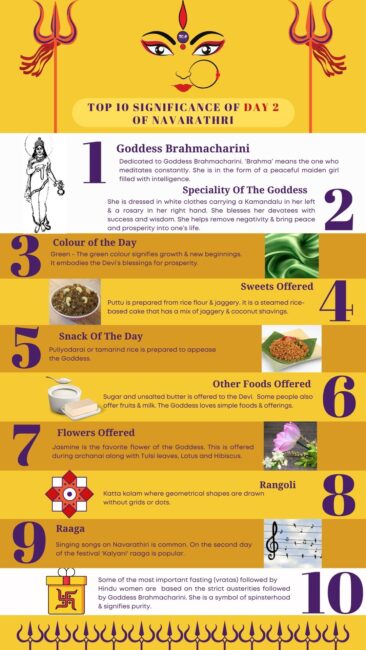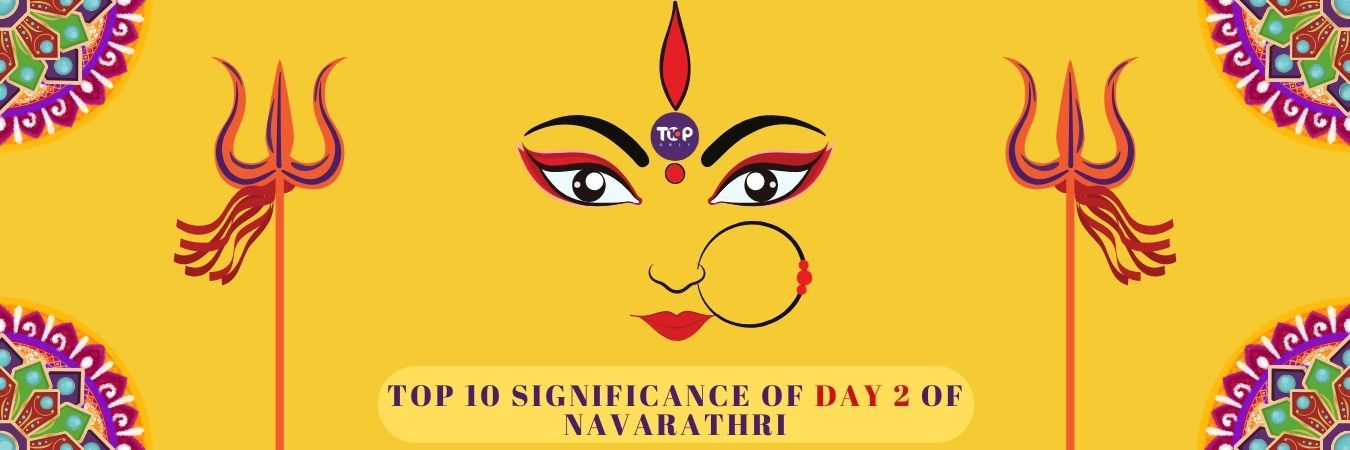Updated on: 11.09.2024

Navarathri is one of the most important festivals celebrated in India. Devotees immerse themselves in prayer during all the nine auspicious days of Navarathri. Fasting is observed by many devotees seeking the blessing of the Goddess Maa Durga. The festivities include the worship of all nine goddesses, called the Navadurgas, in nine days and following the different traditions ascribed to the specific goddess of that particular day.
Top 10s Only presents a brief look at Day 2 of the Navarathri festival that will be celebrated on October 4, 2024 (Friday). Make sure to check out our article that lists the top 10 important aspects of Day 1 of Navarathri too!
Significance Of Day 2 Of Navarathri
The second day of Navarathri commemorates the severe penance that the Goddess Maa Brahmacharini had to undergo to attain Lord Shiva as her husband. She took sage Narada’s advice and embarked on a deep tapasya or penance for many years. She would walk barefoot and live off fruits and leaves as part of her penance journey. After a while, she stopped having any form of food and merely lived with breathing. She is said to have become so thin that it worried the Gods.
1. The Name of Goddess Worshipped On Day 2 Of Navarathri
The second day of Navarathri is dedicated to Goddess Maa Brahmacharini. This is the Goddess Maa Durga’s second manifestation and she is worshipped with elaborate and colourful rituals. ‘Brahma’ means the one who meditates constantly and is the possessor of sacred knowledge. It also means the unmarried one. Brahmacharini simply means a devoted female student who spends her life in an Ashram with her Guru and other students. Since the Goddess Maa Brahmacharini was fasting, she is also called ‘Aparna,’ which means one who can live even without eating leaves. She is also known by the names Raja Rajeshwari and Kowmaari.
From her previous birth as Sati, Devi Maa Brahmacharini was reincarnated as the daughter of the king of mountains. Upon being advised by sage Narada, she went into deep penance for thousands of years to attain Lord Shiva as her consort. She abstained completely from water and food and consumed only Bilva leaves for survival. Due to her undertaking severe penances, the unmarried form of Goddess Parvati was called Brahmacharini. Maa Brahmacharini devoted herself to Lord Shiva. This pleased Lord Shiva who married her eventually.
2. The Speciality Of The Goddess Worshipped On Day 2 Of Navarathri
The Day 2 Navarathri Goddess Maa Brahmacharini is depicted as a majestic, radiant and serene-looking maiden draped in a simple white saree. She is shown as being barefoot, with a Kamandalu (pot) in her left hand and a rosary in her right hand. Maa Brahmacharini is known to bless her devotees with success and wisdom. The Goddess helps remove negativity and bring peace and prosperity into one’s life. This divine form of Devi Maa Parvati as Maa Brahmacharini is assured to bring a sense of calm and tranquillity into the minds of all devotees.
3. The Colour On Day 2 Of Navarathri
Navarathri Day 2 colour is Green. Green signifies growth and new beginnings. It symbolizes the blessing of the Goddess. Devotees are often seen wearing clothes of this colour to mark the significance of this day.
4. The Sweets To Be Offered On Day 2 Of Navarathri
On Day 2 of Navarathri, the traditional dish ‘Puttu’ is prepared from rice flour and jaggery as prasad. It is a steamed rice-based cake that has a mix of jaggery and coconut shavings. As simple as it sounds, the labour required to prepare the sweet is intensive. Yet devotees prepare it happily and offer it to Maa Brahmacharini as means to obtain her blessings.
5. The Snacks To Be Offered On Day 2 Of Navarathri
Along with the above-mentioned offering for Navarathri Day 2 , Puliyodarai or tamarind rice is prepared to appease Maa Brahmacharini. After prayer rituals, the Prasad is first given to unmarried women and young girls in the family who are viewed as the symbol of Goddess Durga.
6. The Other Food Items To Be Offered On Day 2 Of Navarathri
On Navratri Day 2, devotees also offer sugar and unsalted butter as naivedyam or offering to Maa Brahmacharini. It is believed that Maa Brahmacharini favours simple foods and offerings. Some people also offer fruits and milk to the Goddess.
7. The Flowers To Be Offered On Day 2 Of Navarathri
On Day 2 Navarathri, jasmine flowers are offered as aarti to Maa Brahmacharini as it is the Goddess’s favourite flower. Lotus and hibiscus flowers are also offered to the Goddess. Even Tulsi leaves are offered during prayer.
8. The Rangoli On Day 2 Of Navarathri
One of the most significant tasks on Navarathri Day 2 is making Katta kolam, where geometrical shapes are drawn without grids or dots. They are a speciality on this day.
9. The Raaga On On Day 2 Of Navarathri
Navratri Day 2 songs or bhajans are sung in Kalyani raagam to appease Maa Brahmacharini. This raagam is said to be a powerful raga for meditation and is believed to remove sadness.
10. The Belief On Day 2 Of Navarathri
Day 2 of Navarathri symbolizes the humble aura of the Goddess Maa Brahmacharini and her struggles to attain her goal with patience. She bore hunger, climatic conditions, etc., during her penance, for over thousands of years. Maa Brahmacharini’s abode is Swadisthan Chakra. Some of the most important fasting (vratas) practices followed by Hindu women are based on the strict austerities followed by the Devi. This Goddess Maa Brahmacharini is a symbol of spinsterhood and signifies purity.
On Day 2 of Navarathri, the Goddess Maa Brahmacharini is believed to descend to earth to be with her devotees. Worshipping her with reverence is believed to bring success, prosperity, and happiness. Devi Maa Brahmacharini’s struggles during her period of penance are remembered with great admiration and respect. Ardent worship of the Goddess Maa Brahmacharini is equal to doing severe penance. It is believed that all the benefits one may get by performing long penance are achieved through sincere and devoted prayer to her. Therefore, all obstacles that you may encounter for success or even progress are removed and only satisfaction and peace remain with the family.
Rituals may differ slightly from place to place. What are the rituals you perform? Let us know in the comments.
Familiarise yourself with the traditions associated with this magnificent festival by reading the Significance Of Day 3 of Navarathri.


Pingback:Navarathri Day 1 Significance - Maa Shailaputri | Top 10s Only